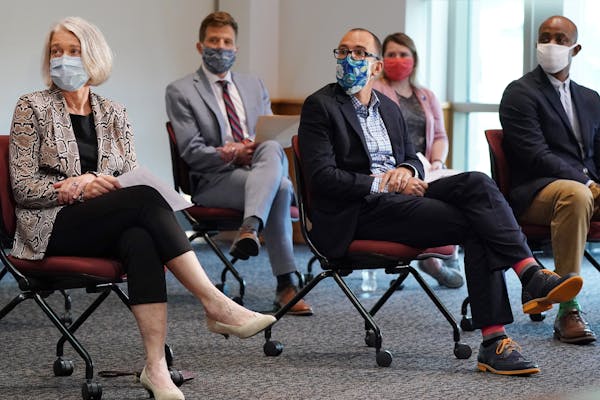The coronavirus load in Twin Cities wastewater more than doubled over the past week, indicating a rising spread of COVID-19 in Minnesota.
The increase reported Friday by the Metropolitan Council was influenced by a one-day spike on April 17, when the viral load surged to the highest level since January's severe omicron COVID-19 wave. However, the viral load in samples from the St. Paul treatment plant rose steadily on other days last week as well, and the uptick matches recent increases in COVID-19 cases and hospitalizations.
The Minnesota Department of Health on Friday reported another 1,464 coronavirus infections, excluding infections identified by at-home antigen tests that aren't publicly reported. The seven-day average of new infections was 398 per day on April 1, but it increased to 827 on Tuesday. COVID-19 hospitalizations in Minnesota rose from 183 on April 10 to 234 on Thursday.
The rising totals remain far below pandemic peaks — with new cases exceeding 13,000 per day in mid-January and hospitalizations reaching 1,629 on Jan. 14. State Health Commissioner Jan Malcolm said she is encouraged that the latest growth in infections and viral load in wastewater hasn't been worse, or pressured hospitals.
"If you're only looking at percentage increases, it looks like, 'Oh my gosh!'" Malcolm said, "but the actual viral load is such a small proportion of what it was at the height" of the omicron wave.
Only 24 of the COVID-19 hospitalizations on Thursday involved people placed in intensive care. That represents 10% of COVID-19 hospitalizations, the lowest rate in the pandemic. The falling ICU usage rate suggests the current virus might be milder, treatments are improving or that recent infections and vaccinations have left many Minnesotans with immunity against severe illness.
"A case is not a case in the same way, perhaps, in terms of the impact on health and the disruption and pressures on the health care system," Malcolm said.
A review of blood drawn for various medical tests in January found that more than 48% showed the presence of coronavirus antibodies following infections. The Centers for Disease Control and Prevention consequently estimated that nearly 2.7 million Minnesotans already had been infected by then — compared with the 1.4 million that have been identified by reportable COVID-19 tests.
Minnesota's COVID-19 death toll is 12,492, including 10 deaths reported on Friday.
Health officials are concerned immunity levels from recent infections and vaccinations could be waning and people could become more vulnerable to COVID-19 again. While Minnesota is ahead of national averages on COVID-19 vaccinations, the state estimates only 49% of residents 5 and older are up to date with their shots. Up to date means they either recently received their initial doses or received scheduled first boosters to maintain immunity.
The abundance of treatment options also has resulted in a test-to-treat approach in which doctors and prescribers can directly order antiviral pills or monoclonal antibody infusions when patients test positive.
The state this week reported about 14,000 available courses of Paxlovid, an antiviral pill that is most effective when taken shortly after infection. Some monoclonal antibodies have been phased out because they don't work against circulating strains of the virus, but the state has about 3,500 courses of bebtelovimab, which remains effective.
COVID-19 activity in Minnesota is being fueled by a fast-spreading BA.2 coronavirus subvariant, which recently caused pandemic waves in several European nations. Wastewater sampling showed that BA.2 was responsible for more than 90% of the viral load in the Twin Cities over the past week.
Malcolm said people should evaluate their personal risks as they decide whether to wear masks and go out in public, but be mindful that some people are more vulnerable to the virus and have conditions that make them ineligible for the vaccine.
"There is always the desire to say, 'It's so great to get back to normal,' and there is an element of truth in that for a lot of us, that we can get back to doing a lot more," she said. "There just needs to be this acknowledgment that this is not true for everybody."

Fall or spring, it's Rochester Mayo's year in prep tennis

Minneapolis reaches $150k settlement with eyewitness of George Floyd's murder

Israel-Hamas war creates 'really fraught times' at Minn. colleges

Rare and fatal brain disease in two deer hunters heightens concerns about CWD

